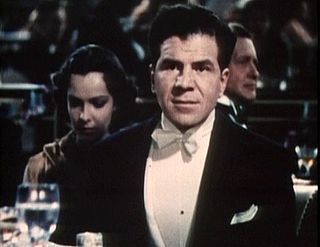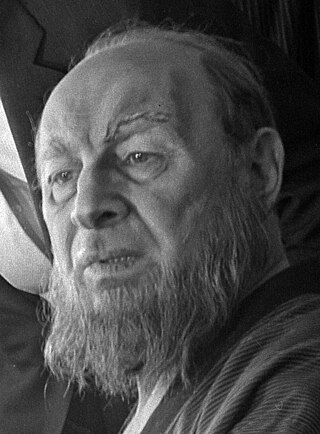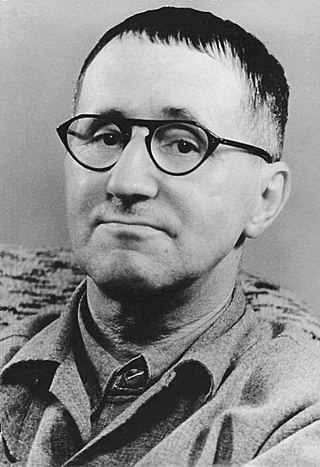Related Research Articles

Charles Laughton was a British-American actor. He was trained in London at the Royal Academy of Dramatic Art and first appeared professionally on the stage in 1926. In 1927, he was cast in a play with his future wife Elsa Lanchester, with whom he lived and worked until his death.

Joseph Walton Losey III was an American theatre and film director, producer, and screenwriter. Born in Wisconsin, he studied in Germany with Bertolt Brecht and then returned to the United States. Blacklisted by Hollywood in the 1950s, he moved to Europe where he made the remainder of his films, mostly in the United Kingdom. Among the most critically and commercially successful were the films with screenplays by Harold Pinter: The Servant (1963) and The Go-Between (1971).

Life of Galileo, also known as Galileo, is a play by the 20th century German dramatist Bertolt Brecht and collaborator Margarete Steffin with incidental music by Hanns Eisler. The play was written in 1938 and received its first theatrical production at the Zurich Schauspielhaus, opening on the 9th of September 1943. This production was directed by Leonard Steckel, with set-design by Teo Otto. The cast included Steckel himself, Karl Paryla and Wolfgang Langhoff.

Mother Courage and Her Children is a play written in 1939 by the German dramatist and poet Bertolt Brecht (1898–1956), with significant contributions from Margarete Steffin. Four theatrical productions were produced in Switzerland and Germany from 1941 to 1952, the last three supervised and/or directed by Brecht, who had returned to East Germany from the United States.

Mary Frances Heflin was an American actress. She is best known for her role as Mona Kane Tyler on the soap opera All My Children (1970–1994).

Lionel Jay Stander was an American actor, activist, and a founding member of the Screen Actors Guild. He had an extensive career in theatre, film, radio, and television that spanned nearly 70 years, from 1928 until 1994. He was known for his distinctive raspy voice and tough-guy demeanor, as well as for his vocal left-wing political stances. One of the first Hollywood actors to be subpoenaed before the House Un-American Activities Committee, he was blacklisted from the late 1940s until the mid-1960s.

Salka Viertel was an Austrian actress and Hollywood screenwriter. While under contract with Metro-Goldwyn-Mayer from 1933 to 1937, Viertel co-wrote the scripts for many movies, particularly those starring her close friend Greta Garbo, including Queen Christina (1933) and Anna Karenina (1935). She also played opposite Garbo in MGM's German-language version of Anna Christie in 1930.

Morris Carnovsky was an American stage and film actor. He was one of the founders of the Group Theatre (1931-1940) in New York City and had a thriving acting career both on Broadway and in films until, in the early 1950s, professional colleagues told the House Un-American Activities Committee that Carnovsky had been a Communist Party member. He was blacklisted and worked less frequently for a few years, but then re-established his acting career, taking on many Shakespearean roles at the Stratford Shakespeare Festival and performing the title roles in college campus productions of King Lear and The Merchant of Venice. Carnovsky's nephew is veteran character actor and longtime "Pathmark Guy" James Karen.
Phoebe Brand was an American actress.

Baal was the first full-length play written by the German modernist playwright Bertolt Brecht. It concerns a wastrel youth who becomes involved in several sexual affairs and at least one murder. It was written in 1918, when Brecht was a 20-year-old student at Munich University, in response to the expressionist drama The Loner by the soon-to-become-Nazi dramatist Hanns Johst.
The Coronet Theatre is a theatre located at 366 North La Cienega Boulevard in Los Angeles, California. During its peak in the mid 20th century, it was a legitimate theatre and experimental cinema venue, showing the work of people such as Kenneth Anger, Man Ray, Peter Berg, and Richard Vetere. Over the years its stage has hosted such stars as John Houseman, Charles Laughton, Charlton Heston, Buster Keaton, Ethel Waters, James Coburn, George C. Scott, Carol Burnett, Noah Wyle, and Glenn Close.
George Louis Schaefer was an American director of television and Broadway theatre, who was active from the 1950s to the 1990s.
Barrie Stavis was an American playwright. He wrote several plays about men struggling in the vortex of history. His subjects include scientist Galileo, abolitionist John Brown, and labor leader Joe Hill. His play, Lamp at Midnight, about Galileo's struggle with the Catholic Church to get his ideas accepted, was performed and televised on the Hallmark Hall of Fame in 1966. Melvyn Douglas starred as Galileo.
Round Heads and Pointed Heads is an epic parable play written by the German dramatist Bertolt Brecht, in collaboration with Margarete Steffin, Emil Burri, Elisabeth Hauptmann, and the composer Hanns Eisler. The play's subtitle is Money Calls to Money and its authors describe it as "a tale of horror." The play is a satirical anti-Nazi parable about a fictitious country called Yahoo in which the rulers maintain their control by setting the people with round heads against those with pointed heads, thereby substituting racial relations for their antagonistic class relations. The play is composed of 11 scenes in prose and blank verse and 13 songs. Unlike another of Brecht's plays from this period, The Mother, Round Heads and Pointed Heads was addressed to a wide audience, Brecht suggested, and took account of "purely entertainment considerations." Brecht's notes on the play, written in 1936, contain the earliest theoretical application of his "defamiliarization" principle to his own "non-Aristotelian" drama.

Galileo is a 1975 biographical film about the 16th- and 17th-century scientist Galileo Galilei, whose astronomical observations with the newly invented telescope led to a profound conflict with the Roman Catholic Church. The film is an adaptation of Bertolt Brecht's 1943 play of the same name. The film was produced by Ely Landau for the American Film Theatre, which presented thirteen film adaptations of plays in the United States from 1973 to 1975. Brecht's play was recently called a "masterpiece" by veteran theater critic Michael Billington, as Martin Esslin had in 1960. The film's director, Joseph Losey, had also directed the first performances of the play in 1947 in the US — with Brecht's active participation. The film is fairly true to those first performances, and is thus of historical significance as well.
George Schaefer Showcase Theatre was a syndicated series that ran on cable channels in the 1980s. It consisted of videotaped productions in color directed by George Schaefer which had originally been telecast on the Hallmark Hall of Fame and had been sold as a television package to stations around the U.S.

Eugen Berthold Friedrich Brecht, known professionally as Bertolt Brecht, was a German theatre practitioner, playwright, and poet. Coming of age during the Weimar Republic, he had his first successes as a playwright in Munich and moved to Berlin in 1924, where he wrote The Threepenny Opera with Elisabeth Hauptmann & Kurt Weill and began a life-long collaboration with the composer Hanns Eisler. Immersed in Marxist thought during this period, he wrote didactic Lehrstücke and became a leading theoretician of epic theatre and the Verfremdungseffekt.
Barbara Bray was an English translator and critic.
Serge Hovey was a composer and ethnomusicologist.

Pacific Resident Theatre (PRT) is a 501(c)(3) non-profit theatre company located at 703 Venice Boulevard in Venice, California. It was founded as an actors cooperative in Venice's arts district in 1985 and is dedicated to producing both classic and little known plays, as well as works by new authors. As of June 2012, the company had received over 90 awards, including NAACP Image Awards, 73 (as of 2013) Los Angeles Drama Critics Circle Awards. and the since-retired LA Weekly Theater Awards (defunct 2014), Drama-Logue Awards (defunct 1998) and Back Stage West Garland Awards (defunct 2009).
References
- ↑ Stavis, Barrie (1948). Lamp at Midnight: A Play in Three Acts. Dramatists Play Service. OCLC 3067032.
- 1 2 Atkinson, Brooks (December 22, 1947). "At the Theater" . The New York Times .
It is a deeply moving play with a passionate theme and a resolute point of view.
- ↑ Billington, Michael (February 13, 2013). "A Life of Galileo – review". The Guardian .
the real pleasure of Roxana Silbert's modern-dress RSC revival and Mark Ravenhill's slimmed-down translation lies in the absolute clarity with which they put Brecht's masterpiece before us.
- ↑ Mitchell, Richard W. (2003). Brecht in L.A.: A Play. Intellect Books. p. 168. ISBN 9781841501055.
In Los Angeles, Brecht worked for several years with Laughton on an English translation/adaptation, Galileo, which opened in 1947 in Los Angeles and then on Broadway with Laughton playing the title role. The American productions, directed by Joseph Losey (with a great deal of input from Brecht), received mixed reviews in Los Angeles and harsher reviews in New York, where the production met with less success than another play about Galileo, The Lamp at Midnight, by Barrie Stavis, which opened two weeks after Brecht's play.
- ↑ "'Lamp at Midnight' to Star Carnovsky" . The New York Times. June 14, 1968.
- ↑ Gould, Jack (April 28, 1966). "TV: Static View of Galileo's Ordeal" . The New York Times.
It was an hour of interesting storytelling, but hardly stimulating theater.
- ↑ Erickson, Hal. "Lamp at Midnight (1966)". allmovie.
- ↑ Lamp at Midnight. Films for the Humanities. 1983. OCLC 11689040.